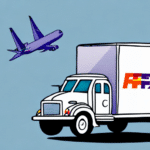Exception Delivery: How to Ensure Your Packages Reach Their Destination On Time
As an e-commerce business owner, timely delivery is crucial for ensuring customer satisfaction and retention. In today's fast-paced environment, customers expect their packages to arrive promptly, and delays or late deliveries can significantly impact your business reputation and revenue. This article explores the various aspects of package delivery logistics and provides comprehensive tips for ensuring exceptional delivery services every time.
The Importance of On-Time Delivery in Today's E-commerce Landscape
With the surge in online shopping, customers have grown accustomed to fast and reliable delivery services. According to a Statista survey, 96% of customers consider on-time delivery important when choosing an e-commerce retailer. Additionally, 81% of customers are unlikely to make repeat purchases from a company after experiencing a late delivery. Prioritizing timely deliveries is essential for retaining customers and fostering business growth.
To ensure on-time delivery, collaborate with reliable shipping carriers known for their punctuality. Research and select carriers with a proven track record of timely deliveries. Investing in advanced tracking technology allows you to monitor shipments in real-time and address any arising issues promptly.
Packaging plays a vital role in delivery efficiency. Poorly packaged items can sustain damage during transit, leading to delays. Utilize sturdy packaging materials and add extra padding or protection for fragile items. These measures not only improve delivery times but also enhance the overall customer experience.
Consequences of Delivery Delays and How They Affect Your Business
Delays and late deliveries can severely damage your business reputation, increase customer service costs, and result in lost sales. Dissatisfied customers may leave negative reviews, share their experiences on social media, and discourage others from using your services. According to a PwC report, poor delivery experiences lead to increased customer churn and reduced lifetime value.
Moreover, delivery delays can lead to legal repercussions. If a customer's business operations are disrupted due to a late delivery, they may seek compensation for lost profits or damages, resulting in costly legal fees and a tarnished reputation.
Consistently failing to meet delivery deadlines can also strain relationships with suppliers and partners, limiting your options for sourcing materials and impacting your bottom line.
Understanding the Logistics of Package Delivery
Effective package delivery logistics involve several critical steps:
- Order Processing: Receiving and verifying orders, calculating order values, and creating packing slips.
- Order Fulfillment: Picking, packing, and shipping orders to customers.
- Shipping Carrier Selection: Choosing the right carrier based on delivery speed, cost, package weight, and distance.
- Order Tracking: Providing customers with real-time updates on their package's location and expected delivery date.
- Customer Communication: Informing customers of any delays or delivery updates.
Effective inventory management is also essential. Maintaining optimal stock levels, monitoring product demand, and ensuring product availability prevent stockouts, reduce shipping times, and enhance customer satisfaction. Additionally, consider the environmental impact of your delivery logistics by opting for eco-friendly packaging materials and optimizing delivery routes to minimize carbon emissions.
Choosing the Right Shipping Carrier for Your Business
Selecting the appropriate shipping carrier is vital for ensuring timely deliveries. Different carriers offer varying rates, services, and shipping speeds. When selecting a carrier, evaluate factors such as delivery speed, package weight and size, destination, and cost. Reviewing carrier reliability and their track record for on-time delivery is crucial.
Consider partnering with a third-party logistics provider (3PL) to help identify the best carrier for your business needs and streamline your delivery process. A reputable 3PL can assist with carrier selection, negotiate better shipping rates, and manage logistics efficiently.
Additionally, prioritize carriers with excellent customer service. Responsive and helpful customer support can assist in resolving any issues that arise during the shipping process. Look for carriers that offer additional services like insurance, package tracking, and delivery confirmation to provide added assurance for both you and your customers.
The Role of Tracking and Communication in Successful Deliveries
Effective tracking and communication are pivotal in ensuring timely and successful deliveries. Providing customers with real-time updates on their package's location and expected delivery date helps them plan accordingly and reduces the likelihood of missed deliveries. Transparency about any delays or changes in delivery status is equally important.
Utilizing advanced tracking systems allows you to identify and address delivery issues promptly. This proactive approach not only resolves problems quickly but also enhances customer trust and satisfaction. According to a NimbleFins study, effective communication contributes significantly to improving overall customer experience and loyalty.
Consistent and clear communication fosters trust, encouraging repeat business and positive word-of-mouth recommendations, which are invaluable in today's competitive market.
Tips for Packaging Your Products to Minimize Damage in Transit
Proper packaging is essential to minimize damage during shipping. Here are some best practices:
- Use Sturdy Boxes: Choose reinforced boxes that can withstand rough handling.
- Protect Fragile Items: Wrap delicate items in bubble wrap or packaging peanuts and secure them with strong tape.
- Label Clearly: Clearly label packages and consider adding "Fragile" or "Handle with Care" stickers to prevent mishandling.
- Optimize Box Size: Select the right size box to prevent items from moving during transit. Avoid oversized boxes that can cause items to shift and become damaged.
- Consider Weight Distribution: Ensure that the box can support the weight of the contents without breaking or tearing.
Effective packaging not only reduces the risk of damage but also enhances customer satisfaction by ensuring that products arrive in excellent condition.
Addressing Common Delivery Challenges: Weather and Traffic
Delivery challenges such as adverse weather conditions and heavy traffic can cause delays. To mitigate these issues:
- Monitor Conditions: Keep an eye on weather forecasts and traffic updates to adjust delivery schedules proactively.
- Alternative Delivery Methods: Consider offering same-day or next-day delivery options to compensate for potential delays.
- Route Optimization: Utilize route optimization software to plan the most efficient delivery routes, taking into account traffic patterns, road closures, and delivery windows.
- Customer Communication: Inform customers about any potential delays and provide regular updates to manage expectations.
By implementing these strategies, you can minimize the impact of external factors on your delivery times and maintain a reliable delivery service.
Mitigating Risks with Insurance and Liability Coverage
Despite best efforts, delivery accidents can occur, leading to damaged or lost packages. To mitigate these risks:
- Obtain Insurance: Purchase insurance coverage that protects your goods against damage or loss during transit.
- Understand Policies: Carefully read and understand insurance policies to ensure they cover your specific business needs.
- Liability Coverage: Secure liability coverage to protect your business from potential legal claims arising from delivery issues.
Having adequate insurance and liability coverage safeguards your business finances and maintains customer trust in cases of unforeseen delivery problems.
The Benefits of Partnering with a Third-Party Logistics Provider
Partnering with a third-party logistics provider (3PL) offers numerous advantages for your delivery process:
- Streamlined Operations: A 3PL handles carrier selection, order processing, fulfillment, and customer communication, allowing you to focus on core business activities.
- Cost Savings: 3PLs often negotiate discounted shipping rates with carriers, reducing your overall shipping costs.
- Scalability: As your business grows, a 3PL can scale its services to accommodate increased order volumes without compromising delivery efficiency.
- Expertise: Leverage the expertise of logistics professionals to optimize your delivery strategies and improve overall efficiency.
Collaborating with a reputable 3PL can enhance your delivery capabilities, reduce operational burdens, and contribute to sustained business growth.
Adapting to Changes in Delivery Dynamics Post COVID-19
The COVID-19 pandemic significantly disrupted traditional package delivery processes due to reduced carrier capacity, increased demand, and the implementation of safety protocols. To adapt to these changes:
- Alternative Delivery Methods: Explore contactless delivery, curbside pickup, or locker pickup to accommodate safety requirements and customer preferences.
- Enhanced Safety Measures: Implement and communicate safety protocols to protect both employees and customers during the delivery process.
- Flexible Logistics: Adjust your logistics strategies to handle fluctuations in order volumes and carrier availability effectively.
- Customer Communication: Keep customers informed about any changes in delivery times or processes to maintain transparency and trust.
By embracing these adaptations, your business can navigate the evolving delivery landscape and maintain reliable service levels.
Enhancing Customer Experience with Efficient Shipping Practices
Efficient shipping practices play a crucial role in enhancing the overall customer experience and building loyalty. Consider the following strategies:
- Offer Free Shipping: Providing free shipping can attract more customers and increase conversion rates.
- Provide Faster Delivery Options: Offer expedited shipping options such as same-day or next-day delivery to meet customer expectations.
- Implement Effective Tracking: Ensure that customers have access to real-time tracking information to stay informed about their orders.
- Transparent Communication: Keep customers updated about their order status, including any potential delays, to manage expectations effectively.
By implementing these shipping practices, you can deliver a superior customer experience, fostering loyalty and encouraging repeat business.
The Future of Package Delivery: Trends and Innovations
As e-commerce continues to expand, package delivery is evolving with emerging trends and innovations:
- Drones and Autonomous Vehicles: These technologies promise to revolutionize delivery speeds and efficiency by reducing reliance on traditional transportation methods.
- Delivery Robots: Autonomous delivery robots are being tested in urban environments, offering convenient and contactless delivery options.
- Sustainable Delivery Solutions: The demand for eco-friendly delivery options is rising, leading to the development of green packaging materials and optimized delivery routes to minimize carbon footprints.
- Smart Locker Systems: Automated locker systems provide secure and flexible pickup points, enhancing convenience for customers.
Staying informed about these trends and integrating relevant technologies can help your business remain competitive and meet evolving customer expectations.
Case Studies: Success Stories of Exceptional Delivery Services
Examining successful delivery services can provide valuable insights into best practices. Here are a few examples:
- Amazon Prime: By offering same-day and next-day delivery options, Amazon has set a high standard for delivery speed, attracting millions of loyal customers worldwide.
- Zappos: Known for its exceptional customer service, Zappos provides free shipping and returns, ensuring a hassle-free experience that fosters customer loyalty.
- UPS Delivery Innovations: UPS has implemented advanced tracking systems and route optimization software, enhancing delivery efficiency and reliability.
These case studies highlight the importance of investing in reliable delivery infrastructure, prioritizing customer satisfaction, and continuously innovating to stay ahead in the competitive e-commerce landscape.
Conclusion: Key Takeaways for Ensuring Exceptional Package Delivery
Timely delivery is a cornerstone of e-commerce success. To ensure exceptional delivery services every time, consider the following key strategies:
- Effective Communication: Keep customers informed about their order status through real-time tracking and regular updates.
- Reliable Shipping Carriers: Partner with trustworthy carriers and consider the benefits of collaborating with a 3PL.
- Optimal Packaging: Use sturdy packaging materials and proper packing techniques to prevent damage and delays.
- Adaptability: Stay flexible and adapt to changes in delivery dynamics, such as those brought about by global events.
- Embrace Innovation: Incorporate emerging technologies and sustainable practices to enhance delivery efficiency and meet customer expectations.
By implementing these practices, you can deliver an outstanding customer experience, build a loyal customer base, and drive the growth of your e-commerce business.




















